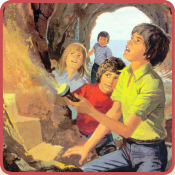
The Talking Teapot and Other Stories

Book Details...
First edition: 1934
Publisher: W. & A.K. Johnston
Illustrator: Peacock and Oxley
Category: Old Thatch Series
Genre: Mixed
Type: Short Story Series Books
Publisher: W. & A.K. Johnston
Illustrator: Peacock and Oxley
Category: Old Thatch Series
Genre: Mixed
Type: Short Story Series Books
On This Page...
Reprints
- The Talking Teapot
Story: Sunny Stories for Little Folks No.95 Jun 1930 - Mr. Tweeky's Magic Pockets
Story: Sunny Stories for Little Folks No.91 Apr 1930 - The Very Old Kettle
Story: Sunny Stories for Little Folks No.87 Feb 1930 - The Apple That Couldn't Be Found
Story: Sunny Stories for Little Folks No.82 Nov 1929 - The Chocolate Cock
Story: Sunny Stories for Little Folks No.100 Aug 1930
Dimble-Dumble discovers a yellow teapot sitting in a gorse bush and as his own teapot is cracked, he takes it home with him although he suspects it probably belongs to the Yellow Gnome. He shouldn't have taken it of course but Dimble-Dumble is not a very honest chap. As he throws out his old teapot to replace it with the lovely new one, his friend Peter Pie drops in and asks to borrow sixpence. Dimble-Dumble says, untruthfully, that he's pretty well broke but then a strange voice is heard and embarrassment ensues. Bobtail, Pipkin, Gillie, Poppo, Chiffle-Chuffle, and Tiptoe all play their parts by being invited to tea at Dimble-Dumble's place and hearing something that causes even more embarrassment for the gnome. The plot has been used several times but this story has its own place.
A round fat little man with the jolliest smile is Mr. Tweeky. He lives in Dum-Dum Village and despite his cheeriness, he has to put up with being rather short of money. One day he runs to the rescue of Mrs. Hubble-Bubble who's fallen victim to a calamity - one of the bathroom pipes has burst and she's being flooded out. Discarding hat and coat, Tweeky thinks quickly, then sticks his thumb into the hole from which the water is gushing while Mrs. Hubble-Bubble runs to fetch the plumber. In about half an hour the pipe is fixed and Mr. Tweeky goes happily on his way. His friend Higgle joins him for a stroll and at dinnertime they decide to have their meal on a sunny bank. Mr. Higgle has quite a nice meal packed up while Mr. Tweeky contemplates the stale dry bread he'd put into his own pocket before setting out earlier that day and wishes he could look forward to cold sausage and jam roll. What's this? Is it magic? He finds he has a great lunch in his pocket after all ... and he's even got some extra money! How extraordinary!
We've had a teapot and now there's a kettle of note that belongs to old Mother Mimble. She looks after her possessions so the teapot's been around for years and has boiled water for thousands of cups of tea. The kettle knew all Mother Mimble's children - Dinah, Judy, Punch, Bobby-Boy, Sally and the baby, but they're all grown up now and have left the nest so Mother Mimble lives alone. A hole has appeared in the bottom of her kettle and it's not surprising when one considers the amount of use it's had over the years. Yes, it's time to discard it for a new one and as people aren't so environmentally minded during this particular period, she takes the kettle to the bottom of the garden and throws it over the hedge. There lies the kettle feeling very homesick for the hob where it once stood, and missing the bright fire, twinkling fender and even the shining poker - all part of its former life. Spring arrives and with it of course, come the birds all looking for places to nest. Every Enid Blyton Fan knows what will happen, and after it has taken place, the kettle is by itself again until Ronnie and his sister happen to mosey along.
Trip, the pixie, has a habit of being very tiresome and his mother doesn't know what to do with him. When he upsets this, breaks that, spills something else, and tears his clothes she's really angry and threatens to wallop him with the yard-broom. "No Ma! Don't do that!" cries Trip so Dame Tuppy tells him to sit down quietly for a while and behave. Sure, he can do that ... but can he? Trip sits down without establishing that a chair is actually between him and the floor so all the dinner things crash down on him when he flings his arm out to save himself by grabbing the tablecloth! What can you do with a person like that? Seeing his ma taking hold of the yard broom he pretends he's hurt and starts crying so Dame Tuppy, feeling sorry for her son, hands him a nice red apple from the barrel - but with an instruction to make himself scarce. "Be a good pixie and run off for a while." Trip does so and ends up on a hilltop where he decides to lie down for a spell before having his bit of fruit. He falls asleep and upon waking, finds his apple gone. The most obvious explanation is that it rolled down the hill so he retraces his steps looking around very carefully and eventually arrives at Blue-shoes' cottage where he finds her hanging out some clothes. As she's munching something, Trip accuses her of eating his apple after it rolled into her garden. Well, Blue-shoes happens to be eating a cake that she made herself and she's not too happy with such an accusation so she takes up a stick and hits the pixie. Trip races further down the hill until he reaches Flip's hut and what do you think - the surly gnome is sitting at the door eating something red! Trip's having a real day of it and continues on with his accusations but only succeeds in making himself look very foolish, and Enid Blyton wonders at the end whether or not he's become a better pixie when he finds out the real truth.
Christmas brings foil covered chocolate Santa Claus figures to brighten up the shops but they aren't the only novelties that attract children because at Easter time the outlets are full of chocolate bunny rabbits, roosters, and chooks. The final tale concerns a cockerel who is so extremely vain that he keeps proclaiming himself as the handsomest bird in the world. That's all very well but the children aren't interested in him. Why? Because he's marked "One Shilling" and they simply can't afford that kind of money. Next to him on the shelf is a chocolate chicken with whom he's become quite friendly but one day the cockerel gets a terrible shock! A little boy, who must be a richer than his chums, buys the chocolate chicken and bites his head off! This is dreadful ... especially when the boy tells the cockerel it'll be his turn next because tomorrow, when his uncle gives him a shilling, he'll be coming back to buy him! The bird shivers and shakes at this statement and determines not to be consumed by a horrid little boy with dirty hands. "I am the handsomest bird in the world! I will not be eaten!" When the boy returns next day the cockerel jumps down to the floor and is out of the door in a twinkling because he has no intention of allowing himself to be stuffed into someone's mouth. He struts down the road and comes to a market where there are turkeys, geese, and ducks all waiting to be bought or sold. A fat little hen asks him what he is and a duck asks him if he can lay eggs. A goose asks if he supplies feathers for pillows and the answers they receive are all in the negative so it appears he's not making much of an impression on these live creatures. The cockerel flies to a horse-trough and declares once again how wonderful he is - not to mention that he's made of chocolate. A little girl passing by makes a grab at him but the bird manages to dodge away and run for his life once again. Soon he reaches a farmyard and starts mingling with the stock - a donkey, goats, horses, cows, turkeys, hens, geese and ducks. The star of this story has to be the most vain character that Enid Blyton ever invented because once again he flies up to a wall and tells them who he is and that he's the handsomest bird in the world - now where have we heard that before? Oh yes, he's also "wise" and "clever!" He then goes even further and practically orders them to make him their king! There's an old saying: "Pride Comes Before a Fall," and "No," he doesn't fall from the wall!
Not sure if the illustrations would be classed as "wonderful" but perhaps they could be looked on as "adequate." It's always nice to have pictures in the Blyton books although it's possible the latest editions of old favourites don't contain so many. An example would be the 1962 version of "The Adventurous Four Again" - a handful, compared to about three dozen in the 1953 version.
It looks as if EB quite liked creating tales about teapots because several of her stories revolve around them. There's The Teapot Head, where a teddy gets a teapot stuck on his bonce, there's also The Teapot Dog, and The Mad Teapot.
The tale of Dimble-Dumble has a similar plot to one of the Rubbalong stories.
Enid Blyton touches on the medieval England with her references to such people as "Old Mother" Mimble or "Dame" Tuppy thus adding extra character to her tales. Admittedly we still use "Dame" these days but not really in the sense it was used several hundred years ago. Constant flitting back and forth between the generations in which the stories are set tends to produce a sense of timelessness similar to that which the Rupert tales exude.
Mother Mimble has a couple of children named Punch and Judy!
Householders used to boil their kettle on the hob - a small metal shelf at the side or back of a fireplace (The Very Old Kettle).
"Wallop" is spelt "wollop" in the book! (The Apple that Couldn't be Found).
The theme of the final story is not unlike that of an old tale - The Gingerbread Man. The cocky little bird can probably claim a record for being the most "full of himself" character ever featured in the Enid Blyton collection, and that includes a boy who made the following remark: "Fancy, no one but me saw that! I really have got brains." (Trotteville). Chocolate birds and rabbits look quite attractive and they draw the children but, eating-wise, they tend to crack and fill one's mouth with thin jagged pieces, which a chocolate buff might choose to avoid.







 Book 1 of 28 in this category
Book 1 of 28 in this category 